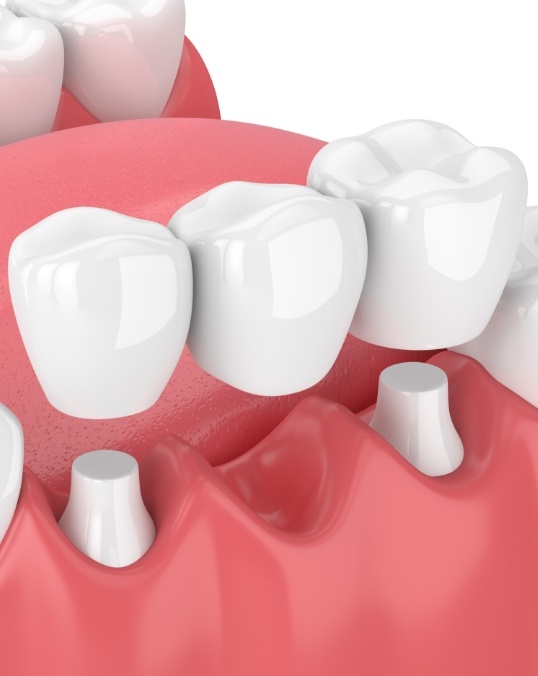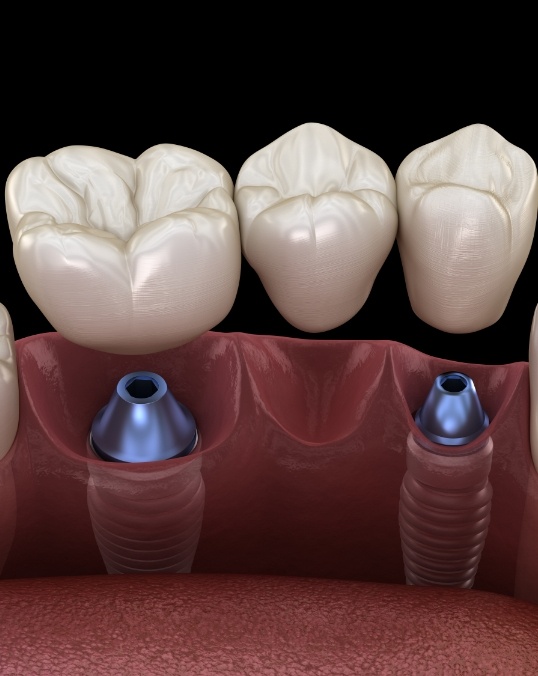Dental Bridges – Saint Peters, MO
Reliable Method for Bridging Gaps in Your Smile
At Klassik Smiles, our team offers several restorative dentistry services to preserve and renew patients’ natural dental structures, including dental bridges. Custom-crafted to fit seamlessly within patients’ smiles, these restorations help replace teeth while restoring a person’s bite. Dr. Kamlesh Makwana has years of experience and provides patients with treatment that exceeds the highest standards. Keep reading or contact our knowledgeable team to find out more about dental bridges in Saint Peters, MO.

Why Choose Klassik Smiles for Dental Bridges?
- We Offer Natural-Looking Dental Restorations
- Dentist with More Than Two Decades of Experience
- Advanced Digital Dental Impression Technology
What Is a Dental Bridge?

This restoration is designed to replace one or several missing teeth in a row. To achieve this, Dr. Makwana will first take impressions of your mouth, using this to recreate the parts of your smile that will need to be replaced. These will be sent to a dental lab so that they can fabricate your new teeth that will blend seamlessly with the rest of your grin. Your dental bridge will be supported by the natural teeth adjacent to the gap, which will have been prepared beforehand.
Types of Dental Bridges

Our team will walk you through your options during your initial consultation, should you be eligible for the treatment. Depending on your situation and dental needs, we’ll recommend providing you with one of the following solutions:
Traditional Dental Bridge

Like a traditional dental crown, fixed bridges require at least two visits to complete. The bridge consists of one or more replacement teeth attached to two dental crowns. Each crown is set in place over the surrounding healthy dental structure to anchor the prosthetic in place. With proper care, fixed bridges can last for decades and look and feel like a natural part of patients’ smiles.
Implant Bridge

For those patients interested in replacing a single tooth or several consecutive teeth without damaging healthy dental structures, dental implant-supported crowns or fixed bridges may be a better option. A single titanium post below the gums can be used to support a dental crown, and two or more implants can be used to support a fixed bridge.
The Benefits of Getting a Dental Bridge

With a dental bridge, you can expect to appreciate several advantages, such as:
- Completely rebuilt smile
- Durable & natural-looking results
- Convenient & cost-effective treatment
- A lifelike solution that can last several years before needing replacements
Dental Bridges FAQs
Can You Take a Dental Bridge Out?
Dental bridges are adhered to the teeth with a strong dental cement designed to hold them firmly in place. Moreover, traditional dental bridges are secured to teeth that have been modified to accommodate them, and that will require the dental bridge for protection. This being the case, dental bridges are not designed to be removed expect by a dental professional.
Partial dentures are sometimes referred to as “removable bridges,” though they’re substantially different from each other in their construction. However, if you’re looking for an oral appliance you can take out for cleaning, this could be a better choice for you.
How Many Teeth Can a Dental Bridge Replace?
Dental bridges are limited in the number of teeth that they can replace by the integrity of the materials that the restoration is made from. Think of it like a real bridge—if it’s too long, it becomes unstable in the center.
In most cases, dental bridges can be used to replace anywhere from one to four consecutive teeth. However, longer bridges tend to fail a bit sooner, so using them to replace only one or two teeth is ideal.
Do Dental Bridges Look Natural?
Dental bridges are often made from tooth-colored materials like ceramic or zirconia and can be customized to match the hue of your natural enamel. The restoration will also be heavily customized to fit you in particular, with everything from their shape to their shading being personalized to match your needs. That being the case, tooth-colored dental bridges should look very natural once they’re in place.
Dental bridges can also be made from metal, which can give them a little bit more durability. However, this obviously won’t look very much like the rest of your smile. Which material you choose comes down to whether you’re willing to trade stability for aesthetics.
How Do I Clean Under My Dental Bridge?
Dental bridges are designed so that they can be brushed just like your natural teeth. However, there’s also a small gap between your gums and your pontics that can collect bacteria if it isn’t cleaned adequately, which means that it’s necessary to clean underneath your dental bridge as well.
This can be done in a variety of ways. Many patients use a floss threader, which they use to get dental floss into this small gap. You could also try an interdental brush, consisting of small bristles attached to a wire that can slip underneath your restoration. If you’re interested in a more high-tech option, you could also try an oral irrigator—these use pressurized water to clean in tight spaces without the need to cram your fingers into your mouth.

